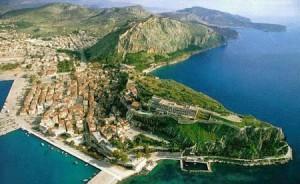Argolida, ...more on Argolida
 ...Visitors have the chance to admire the multiform beauty of the Argolis landscape embellished by green fields, forests, olive groves, villages rooted high up in the mountains, wide grazing plains and lonely, bare mountain tops. Among the uniquely valuable archaeological sites, the contemporary comforts of its tourist-developed cities, the picturesque beauty of the unexplored mountains, and the sweet tranquillity of the fertile meadows, between bare mountain tops and lace-like shores, humble villages and notorious cities, a glorious past and a most promising future, Argolis is here, waiting for you to explore it. ...Visitors have the chance to admire the multiform beauty of the Argolis landscape embellished by green fields, forests, olive groves, villages rooted high up in the mountains, wide grazing plains and lonely, bare mountain tops. Among the uniquely valuable archaeological sites, the contemporary comforts of its tourist-developed cities, the picturesque beauty of the unexplored mountains, and the sweet tranquillity of the fertile meadows, between bare mountain tops and lace-like shores, humble villages and notorious cities, a glorious past and a most promising future, Argolis is here, waiting for you to explore it.
Argolida is also particularly rich as far as archaeological and otherwise cultural resources are concerned. Mesolithic Settlements (dating as far back as 8000 B.C.), Ancient, Byzantine, post Byzantine, and newer monuments, castles and fortresses, sites of superb natural beauty are all dispersed in a relatively small area. Let us name a few: Mycenae, the glorious Mycenaean Citadel with the Cyclopean walls, the palace and the kings’ graves; New Epidauros, where there is the sanctum of the god Asklepios (Asklepius)and the famous theater; The smaller ancient theater in Archaea (or Old) Epidauros; The Mycenaean Citadel of Tiryntha (Tiryns) and Midea; The first Hellenic Palace in Lerna; The Sanctum of Goddess Hera, the Heraion, near Argos; The Market and the ancient theater of Argos; and last, but not least, Nafplio (photo), with its significant historical, cultural and archaeological monuments, such as the castles of Palamidi, Akronafplia, and Bourtzi. |
|



